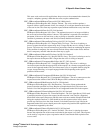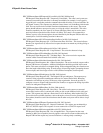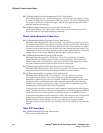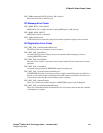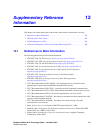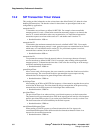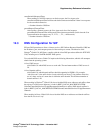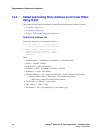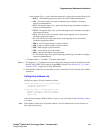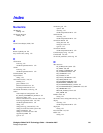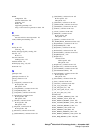Dialogic
®
Global Call IP Technology Guide — November 2007 593
Dialogic Corporation
Supplementary Reference Information
cancelInviteNoResponseTimer
When sending a CANCEL request on an Invite request, the User Agent waits
cancelInviteNoResponseTimer milliseconds before timeout termination if there is no response
for the cancelled transaction.
• Standard duration: 32000 ms
generalRequestTimeoutTimer
After sending a General request, the User Agent waits for a final response
generalRequestTimeoutTimer milliseconds before timeout termination (in this time the User
Agent retransmits the request every T1, 2*T1, ... , T2, ... milliseconds).
• Standard duration: 32000 ms
12.3 DNS Configuration for SIP
SIP uses DNS procedures to allow a client to resolve a SIP Uniform Resource Identifier (URI) into
the IP address, port, and transport protocol of the next hop to contact. The behavior of the
Dialogic
®
Global Call API library complies with the client DNS procedures defined in IETF RFC
3263, including use of NAPTR and SRV DNS queries.
To work with DNS servers, Global Call requires the following information, which it will attempt to
obtain from the operating system:
A list of DNS servers
tells Global Call which DNS servers to work with. The maximum number of DNS servers is
20.
A list of domain suffixes
tells Global Call which domain suffixes should be appended to FQDNs. (For example,
“radvision.com” is the suffix for the “host1.radvision.com” host.) Using suffixes allows the
use of a short version of a name that is within the suffix domain. The maximum number of
domain suffixes is 20.
When working in Windows
®
, Global Call tries to fetch the DNS server addresses and suffixes from
the registry. For DNS server addresses, it looks in HKEY_LOCAL_MACHINE\\SYSTEM
\\CurrentControlSet\\Services\\Tcpip\\Parameters\\NameServer, and for DNS domain suffixes it
looks in HKEY_LOCAL_MACHINE\\SYSTEM\\CurrentControlSet\\Services\\Tcpip\\Parameters
\\Domain.
When working in Linux, Global Call tries to fetch the DNS server addresses and domain suffixes
from the file /etc/resolv.conf.



